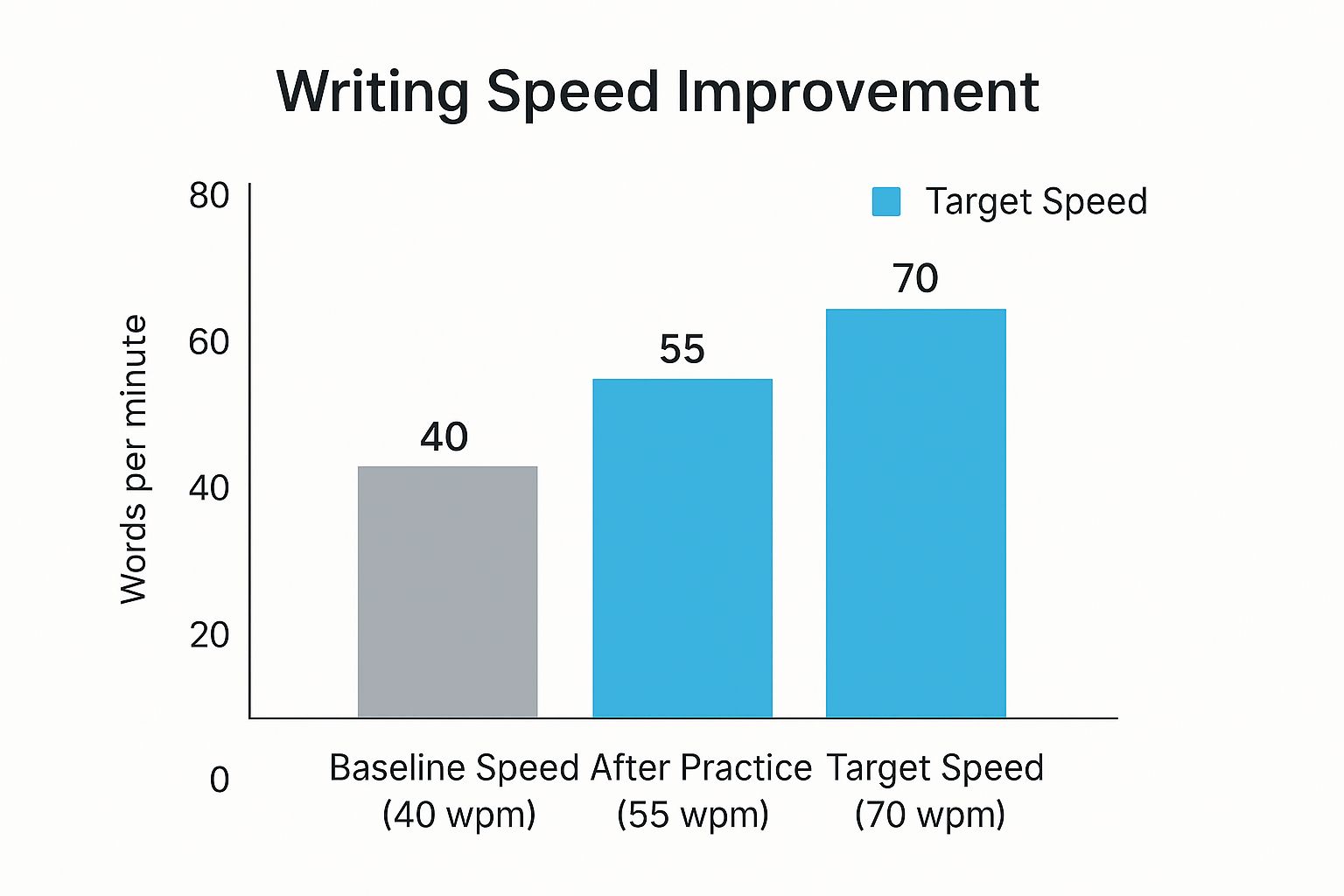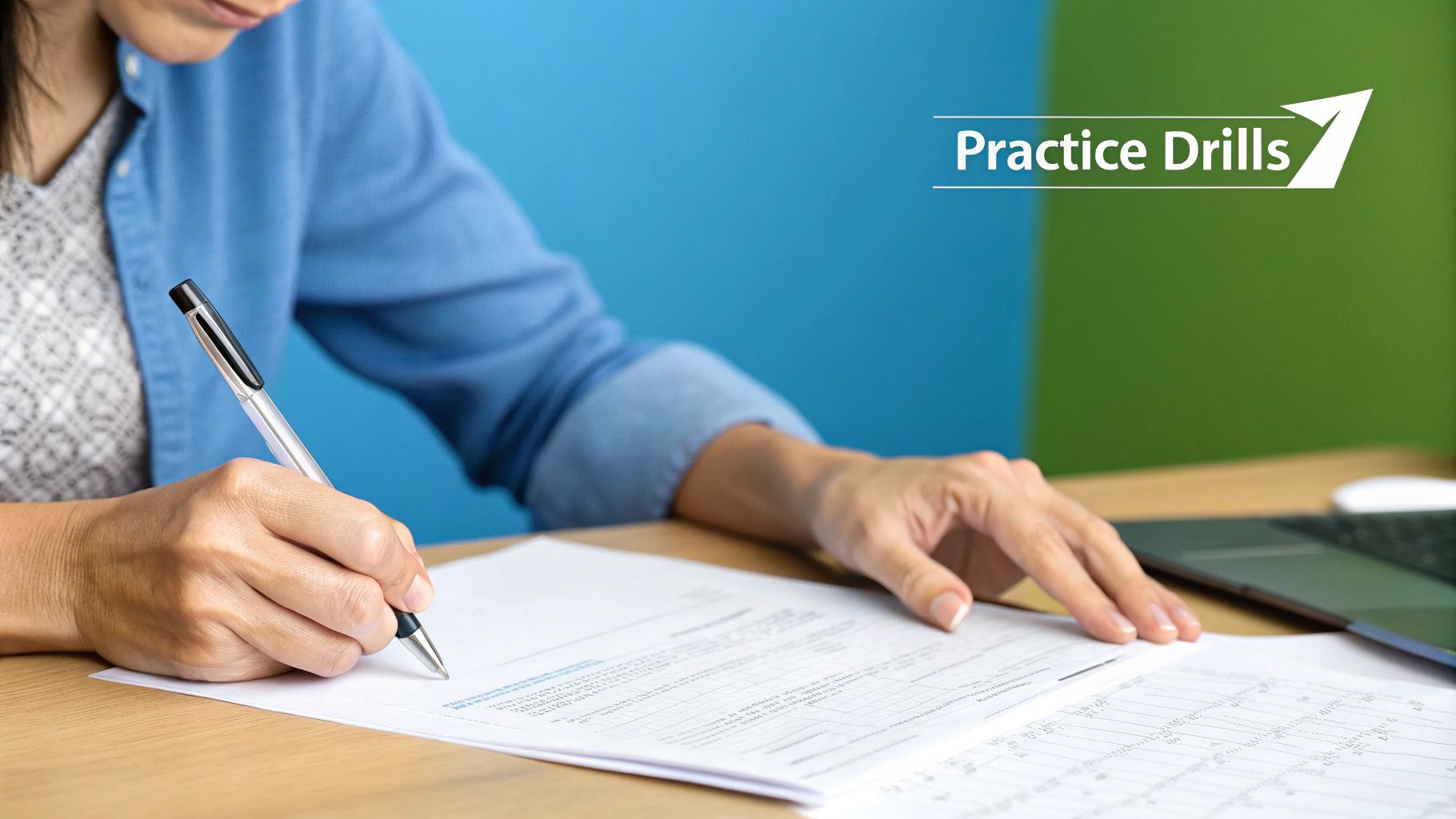Want to get your ideas on paper super fast? There are two main tricks. First, teach your fingers to type without looking. Second, make a quiet spot where you won't get bothered.
When your fingers know where to go and your mind is clear, you can just focus on your words.
Why Writing Faster Is a Superpower
Think about finishing your homework or a school paper in half the time. What would you do with all that extra time? That's what happens when you learn to write faster. It's not about being messy. It's about making writing feel easy.
When you can type fast, you can catch your good ideas before they fly away. Have you ever had a great idea, but by the time you slowly typed it out, it was gone? Writing faster makes a straight line from your brain to the page. No good ideas get lost.
Save Time and Feel Less Stressed
You write all the time. Emails, homework, and messages. If you do it faster, you can save hours every week.
Spending less time fighting with the keyboard also means you feel less stressed. You have more energy for other fun things.
Writing fast is about being quick, not rushing. The goal is to make typing so easy that you don't even have to think about it.
When you're not stuck on one sentence, the words keep coming. This makes writing feel more fun. You can find more strategies to write faster and better to help you.
How Much Time Can You Save?
Seeing the numbers shows you how much time you can really save. Here's a look at how much time you can save on common writing tasks just by going from a slow speed (15 words per minute) to a normal one (40 words per minute).
| Writing Task | Words Needed | Time at 15 WPM | Time at 40 WPM | Time Saved |
|---|---|---|---|---|
| Quick Email | 100 | ~7 minutes | ~2.5 minutes | ~4.5 minutes |
| Short Paper Intro | 250 | ~17 minutes | ~6 minutes | ~11 minutes |
| 1-Page Report | 500 | ~33 minutes | ~12.5 minutes | ~20.5 minutes |
| School Essay | 1,000 | ~67 minutes | ~25 minutes | ~42 minutes |
As you can see, getting even a little faster saves a lot of time in your day.
See Your Speed Go Up
Sometimes, a picture is the best way to see how you're doing. This chart shows how much your words per minute (WPM) can go up with a little bit of practice.


This is not just a small change. As the chart shows, going from slow to fast is a big jump in how much you can do. It's a skill that can change how you do any writing job.
Teach Your Fingers to Fly


Think of your fingers as a team. When they all work together, they can fly across the keyboard. This skill is called touch typing. It’s the best way to write faster.
Every time you look down to find a key, you stop the flow of your thoughts. These little stops add up. They break your focus. When you know where the keys are by feel, your ideas can pour out without stopping.
Use All Ten Fingers
Most of us use just one or two fingers to type. They hop all over the keyboard. To go really fast, you need to use all ten fingers. Every finger needs its own job.
The idea is easy: each finger stays in its own little area of keys. This is much faster than having two fingers run all over the place.
If you want to learn which finger goes where, our guide on how to type faster on any device has games and pictures to help you start.
Make Practice Fun
Learning to touch type doesn't have to be boring. You can get a lot better by playing a fun game for just 10 minutes a day.
Here are some ways to make it fun:
- Play Typing Games: Try websites like Nitro Type or Z-Type. You race cars or shoot aliens by typing words. It's so fun you'll forget you're learning.
- Try the "No Peeking" Game: Put a small towel over your hands. Try to type a simple sentence like, "The quick brown fox jumps over the lazy dog." It will feel weird at first, but it teaches your brain where the keys are.
- Be Right, Not Fast: When you start, don't try to be fast. Just try to hit the right key with the right finger. Once your fingers know what to do, speed will come on its own.
Learning to touch type is like putting money in the bank. A few weeks of short, fun practice can save you hundreds of hours of work later in life.
It's strange, but most people today type only about 52 words per minute. That's slower than people in the 1970s did on old typewriters! Studies show that using all ten fingers and not looking down are the real secrets to speed. Touch typing is a superpower.
Find Your Zone: Make a Great Writing Spot
Where you write is more important than you think. A good spot can help the words flow. A bad spot can make writing feel hard. Your goal is to make a space that tells your brain, "It's time to write."
Think of it like a light switch for your brain. When you sit down, your brain should turn on "writing mode." A messy or loud spot tells your brain to do something else. But a clean, quiet, and comfy spot helps you get started.
Being Comfy Helps You Write
You can't write well if you are always wiggling in your chair or if your back hurts. Being uncomfortable is a big distraction. It pulls your focus away from your words. Making your space comfy isn't just for fun; it helps you write faster.
A few small changes can help a lot:
- Put Your Screen at Eye Level: Don't hunch over your screen. It hurts your neck. Put your screen on some books so you can look straight at it.
- Keep Your Wrists Flat: If your wrists are bent when you type, you can get sore. A special keyboard or a soft pad for your wrists can help you keep them straight and comfy.
- Good Light Is a Must: Writing in a dark room can make your eyes tired. It can even make you sleepy. Bright light from a window or a lamp helps you stay awake and focused.
When your body is comfortable, your mind is free to think and create.
Get Rid of Distractions
The biggest thing that slows you down is not a lack of ideas. It's all the things that pull your attention away. Every text message or "quick" look at a fun website breaks your focus. It can take over 20 minutes to get your focus back after you get distracted.
Make your writing spot a quiet castle. Your focus is your most important tool as a writer. Protect it.
The easiest fix is often the best: put your phone in another room. If you can't see it, you won't think about it. For things on the computer that distract you, use an app like Freedom or Cold Turkey. These apps can block websites for you.
When writing is the only thing you can do, you'll be amazed at how fast you get it done.
Simple Tricks for Faster Handwriting
Even with computers everywhere, we still write with our hands. Think about quick notes in class, filling out a form, or writing a to-do list. Writing faster by hand is a good skill for everyone.
The secret is not to scribble faster. It's about teaching your hand to move in a smooth way. A few small changes can help a lot.
Check How You Hold Your Pen
Look at how you're holding your pen right now. Are you squeezing it really hard? Squeezing too tight makes your hand tired. A tired hand writes slowly.
Try to relax your hand. Hold the pen lightly. This lets your fingers and wrist move easily. You don't need to press hard on the paper. Let the pen do the work.
A simple trick: Pretend your pen is a paintbrush. You want to glide it across the paper, not dig a hole. This idea can help you relax and write more smoothly.
This small change stops your hand from getting sore. You can write for a longer time without your hand cramping up.
Practice Easy Shapes
Just like a runner warms up, your hand can warm up too. Before you start writing, take a minute to draw some easy shapes.
- Loops and Circles: Draw a line of connected loops (like writing the letter 'l' over and over). Or draw a row of small circles. This helps your hand get used to smooth movements.
- Lines and Zig-zags: Draw straight lines and zig-zags across the page. This trains your hand to make the sharp, clean moves you need for letters.
These are not just scribbles. They are exercises for your hand muscles. They help your fingers remember how to make letters. This makes writing feel easier and faster.
How Handwriting Speed Changes with Age
It’s cool to see how handwriting changes as we get older. Most grown-ups write about 13 words per minute. But people who write a lot for their jobs, like teachers, can write much faster, around 15 to 18 words per minute. This shows that practice really helps. You can learn more about how handwriting speeds compare across different age groups on tctecinnovation.com.
The main idea is that handwriting is a physical skill. The more you do it, the better you get.
Use Smart Tools to Write Super Fast
What if you could write just by talking? Our brains think of words much faster than our fingers can type them. The right tools can help you get your thoughts on the page almost as fast as you can think them.
This isn't about cheating. It's about working in a smarter way. You let a computer do the hard part so your brain can focus on your ideas.
Talk, Don't Type
Let's look at the numbers. Most people can talk at about 150 words per minute. That's almost four times faster than most people can type. This is why voice-to-text tools are so great.
These tools listen to you talk and type out your words on the screen. It feels like magic. Instead of staring at a blank page, you can just start talking. Don't worry if you say "um" or if it sounds silly. The goal is just to get your ideas out. You can fix it later.
Getting the first draft done is the hardest part. Talking your ideas can feel like telling a story instead of writing. It's a great way to get started and beat writer's block.
This is a huge help when you have lots of ideas and need to write them down before you forget. To try it, you can learn how to convert audio to text online for free with WriteVoice.
Draw Your Ideas First
Sometimes, the hardest part of writing is knowing what to say next. Before you write your first sentence, you need a plan. A mind map is a great way to make a plan.
A mind map is a drawing of your thoughts. You put your main idea in the middle. Then you draw lines out to other ideas that connect to it. It lets you see your whole plan at once.
Here’s a quick way to make one:
- Start with Your Main Idea: On a piece of paper, draw a circle in the middle. Write your main topic inside. Let's say it's "Fun Summer Activities."
- Add Big Ideas: Draw lines out from the middle circle. At the end of each line, write a big idea. These could be "Going to the Beach," "Playing Sports," and "Making Crafts."
- Add Small Details: Now, add smaller lines to each big idea. Under "Going to the Beach," you could add "building sandcastles" and "swimming."
This drawing is now your map. When you start writing, you don't have to stop and think. You just follow the map you already made. This makes writing much smoother and faster.
Practice Smarter, Not Harder


Just writing more and more doesn't always make you faster. You have to practice the right way. Think of it like a game, not a chore. It's like learning to throw a basketball. You don't just throw the ball at the hoop again and again. First, you practice your aim. Then, you practice your speed.
It’s the same with writing.
Sometimes, you need to practice just for speed. Don't worry about spelling or grammar. Just get the words on the page as fast as you can.
Other times, slow down and practice for quality. Focus on writing good, clear sentences. When you practice speed and quality separately, you get better at both.
Turn Practice Into a Game
Let’s be real, boring practice is no fun. The trick is to make practice feel like a game. You can set up short, fun challenges to push yourself.
Here are a few ideas to try:
- The 15-Minute Story: Set a timer for 15 minutes. Try to write a whole short story before the timer goes off. It doesn't have to be perfect. It just needs a beginning, a middle, and an end.
- Movie Summary Race: Did you just watch a movie? Open a document and try to write down everything that happened as fast as you can. Don't stop to think, just write.
- One-Sentence Game: Pick something in your room, like a lamp or a book. Set a one-minute timer and try to write one super long sentence about it without stopping.
The real secret is to do a little bit every day. You're not trying to become the world's fastest writer in one night. You're building a good habit that makes you a little faster each day.
When you have a big paper due, knowing tricks can help. Learning how to write an essay fast gives you a plan for when you're in a hurry.
Why This Works
There's a reason why practicing in short bursts works. Studies on handwriting show that this kind of practice gets real results. The key is to have one clear goal for each practice session. Either go for speed or go for quality, but don't try to do both at the same time.
This smart practice helps you get more done in less time. By turning practice into little games, you'll see your writing speed get better and better.
Common Questions About Writing Faster
When I talk to people about writing faster, they always have the same worries. They are afraid that writing faster means their writing will be messy. Or they wonder how long it will take to get better. Let’s answer these questions so you can feel good about starting.
First, let's get this straight: faster writing does not have to mean messy writing. The trick is to keep creating and editing separate.
Think of it this way: your first draft is for getting all your ideas out as fast as you can. Don't stop to fix spelling or change a word. Just let it all come out.
After the ideas are on the page, you can become an editor. This is when you slow down, make your sentences better, and fix mistakes. This two-step plan—write fast, then edit slow—is how experts write great things without taking forever.
Where to Start and When You'll See Changes
So, what should you do first? It's simple: Stop looking at your keyboard when you type. This is the most important part of touch typing. It’s a must-have skill if you want to write fast.
It will feel slow and weird at first. That's okay. Pushing through that weird feeling is how your brain learns where the keys are. That’s how you build real speed for the long run.
Don't feel bad if it's hard at first. Every fast typist I know started out slow and clumsy. A little bit of practice every day adds up much faster than you think.
You will see yourself get better very quickly. Just 10-15 minutes of practice each day can make a big difference in a few weeks. Doing a little every day is much better than doing a lot once a week. The goal is not to be a champion overnight. The goal is to build a small, easy habit that makes you faster over time.
Ready to write faster than ever? WriteVoice turns your spoken words into text right away. It lets you write up to four times faster. Try it now and see how much time you can save. Get started for free at https://www.writevoice.io.
